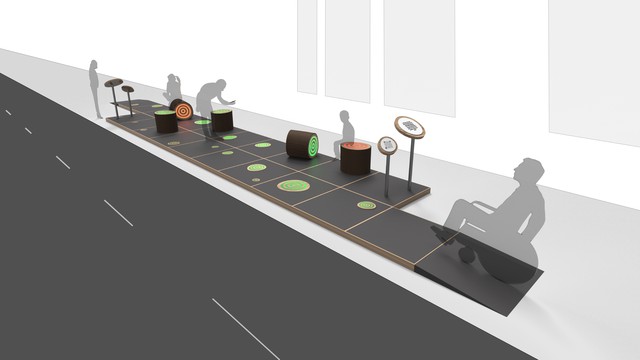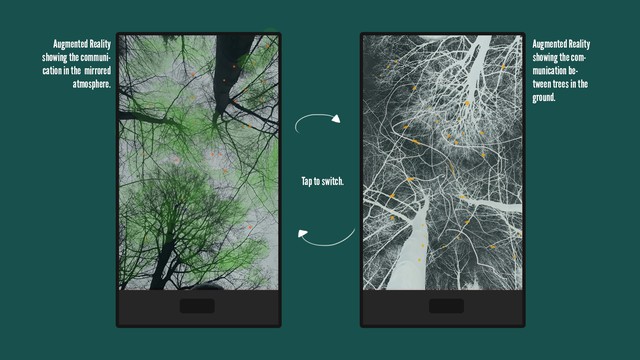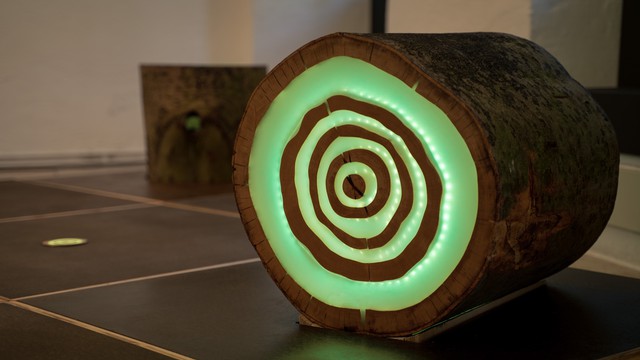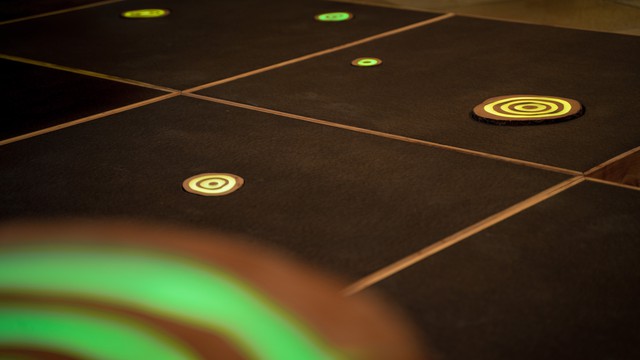NOTHING EXISTS INDEPENDENTLY - how trees communicate 2021, Germany,
A responsive installation for public urban spaces







NOTHING EXISTS INDEPENDENTLY - how trees communicate is a responsive installation for public spaces. It is an urban landmark that creates a meeting ground and relaxation zone for urbanites and passers-by, while raising awareness about the interconnection of trees and the importance of this to us. Using analogue and digital technology to make the connection and communication between trees perceivable, it allows the audience in greenery-free spaces to reconnect with the cradle of the ecosystem earth. The installation is first of all a multi-sensory urban experience and placemaking project. But it also is a call to discuss how we treat our forests, as we need to consider the complexity we live in - socially and ecologically.
The modular installation consists of a physically interactive floor and interactive seating objects, augmented by a digital artwork that can be accessed through smartphones. Interactive wood slices, tree trunk stools and tree trunk benches integrated in squared floor panels contain light strings through which a meditative light pattern constantly pulses, connecting all elements visually. The modular design allows for easy transportation and maximum adaptivity to different spaces. It is also a comment on how humans always try to make things fit into well-measured boxes. Passers-by can physically interact with the installation. Each time somebody steps or sits down on an element, it responds to the presence of the human and changes its light pattern, while all elements of the installation react to the interaction by displaying a short light impulse. The stools and benches are made from beech or oak wood. Both beeches as well as oaks are indigenous European species and are endangered by forestry. Almost no primeval beech or oak forest is left in central Europe. WebAR technology allows to augment the installation with digital content, without having to download an app. By scanning displayed QR codes at the site, visitors can easily access the second layer of the installation, an Augmented Reality website. It enables the users to see the ground becoming a mirror surface, reflecting the tree crowns of a virtual forest. One can now also see through the smartphone what is normally hidden to the human eye. Tiny dots floating in the air become visible - olfactory messages between the trees. When tapping on the screen another invisible universe unfolds - the world within the forest’s ground, intervened by the Mycelium, the fungi system that connects the trees. The visitor can now also see tiny light impulses, visualizing messages sent from tree to tree.
Poster
Details
Team members : Maximiliane Nirschl
Supervisor : Prof. Dr. Reinhard König, Juan Carlos Carvajal Bermúdez
Institution : Bauhaus-Universität, Weimar
Funding agencies : Frauenförderfonds Bauhaus-Universität Weimar
Descriptions
Technical Concept : The physical interaction is realized using the Arduino Technology and a custom button mechanism. The elements (slices, stools and benches) are fixed on top of springs that contract as soon as someone steps or sits on an element. The contraction closes an electrical circuit, making the LEDs react with an adequate light behavior. Using WebAR and the JavaScript library by 8th Wall, the Augmented Reality Artwork is very accessible. Visitors just have to access the corresponding website but don’t need to download anything on their phones. Furthermore, the digital setup remains editable. The used materials are chosen according to their ecological aspects. The floor panels of the original setup are made from an experimental clamping plate, fabricated with organic glue only. The only exception is the use of Resin to create transparent parts to be backlit, due to missing alternatives.
Visual Concept : At first glance, the intervention is a convenient seating area featuring a poetic light setup. It can revitalize a public area of any size as it attracts urbanites and tourists alike and provides a unique environment for various activities. Nature is again used to be put into well measured boxes to serve human needs, just like in so many other areas. A flower bed in front of the window or a lonely tree on the street corner are just examples. But using both analogue and digital technology and media, the installation directs the view further. It makes the passer-by who was just looking for a place to sit aware that we need to change our perspective and relation to nature. We need to look behind the first impressions and start to understand nature as the living inhabitant of the earth it is. We cannot continue using nature whilst denying our interconnection with it.
Credits
Maximiliane Nirschl
Maximiliane Nirschl
Maximiliane Nirschl
Maximiliane Nirschl
Maximiliane Nirschl
Maximiliane Nirschl
Maximiliane Nirschl
Maximiliane Nirschl